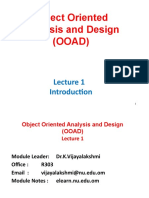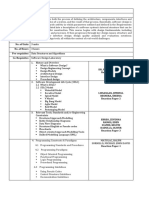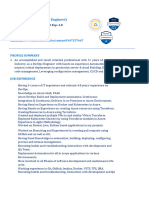University of Science, VNU-HCM
Faculty of Information Technology
Course Introduction
Assoc. Prof. TRAN Minh Triet
Department of Software Engineering
� Course Objectives
❖ This course aims to equip students with basic skills to analyze and
design software.
❖ Upon completion this course, students can:
Describe the common principles to analyze and design software
from software requirements
Apply object oriented methods and techniques to analyze and
design software
Recognize, analyze and evaluate basic pros and cons of an
existing analysis or design model, the architecture of a software
system, the communication between components in a given
system.
Apply basic object oriented techniques to optimize
analysis/design models to enhance the evolution and flexibility of
software systems.
2
� Summary of Content
❖ This course introduces the common principles to analyze and
design software from software requirements.
❖ The content of this course focuses on object oriented techniques
(using UML) to analyze, to design architecture, interface, business
logic, and data.
❖ Several advanced topics can be optionally introduced (e.g. design
patterns, service oriented architecture…)
3
� Assignments, Projects, and Examinations
❖ Midterm exam: 2.5 marks
❖ Final exam: 3.5 marks
❖ Assignments: 1.0 mark
▪ N personal assignments (5 N 10)
▪ Each assignment 1/N mark
▪ Total 1.0 mark
❖ Final Project 3.0+ marks
▪ 2 student(s) per group
▪ Documentation: 1.5+ marks
▪ Application: 1.5+ marks
❖ Advanced Topics +1.0 mark
▪ TBA
4
� Content Outline
Part 1: Overview and Revision
❖ Concepts in Software Engineering
Software
Software Quality
Software Engineering
Software Processes
Object-oriented Software Engineering
❖ Best Practices in Software Development
Develop Iteratively
Manage Requirements
Use Component Architectures
Model Visually (UML)
Continuously Verify Quality
Manage Change
5
� Content Outline
Part 1: Overview and Revision (cont’d)
❖ Concepts in Object-Oriented Programming
Classes and Objects:
▪ Attributes and Methods
▪ Visibility: Public, Protected, Private
▪ Inheritance, Polymorphism
Relationships:
▪ Generalization
▪ Association, Aggregation, Composition
▪ Dependency
Other notations
6
� Content Outline
Part 2: Requirement Modeling
❖ Requirement Modeling with UML – Use-case Diagrams
Problem Statement
Actors and Use-cases
Use-case Model
Use-case Diagram
Relationships in Use-case Diagrams: generalization, <<include>>,
<<extend>>
Use-case Specification: Scenarios, Flows of Events, Alternatives, Pre-
conditions, Post-conditions…
Glossary and Supplemental Specification
Examples
❖ Requirement Modeling with UML – Activity Diagrams
7
� Content Outline
Part 3: Use-case Analysis – Static Analysis
❖ (Analysis) Class Diagrams
Revisions: basic concepts in OOP (again…) and notations in UML
(c.f. Part 1)
How to enhance the capability for software evolution?
(tips and tricks)
Lots of examples!
❖ State Machine diagrams
Concepts and notations
Examples
8
� Content Outline
Part 4: Use-case Analysis – Dynamic Analysis
❖ Analysis Classes
❖ Sequence Diagrams, Communication Diagrams, and VOPCs
Concepts and notations
Examples
9
� Content Outline
Part 5: Data(base) Design
❖ Relational Database Design
Mapping from a class diagram to a relational database
How to enhance the capability for software evolution?
(tips and tricks)
Lots of examples!
❖ XML and Semi-structured Data
Introduction to XML
How to store data using XML
Comparison between relational databases and XML-based data
10
� Content Outline
Part 6: Software Architecture
❖ Introduction to Software Architecture
❖ Layers and Tiers
❖ Some guidelines for Software Architecture Analysis and Design
11
� Content Outline
Part 7: (User) Interface Design
❖ Introduction
Layout and behavior of a (user) interface
Some common approaches for designing user interfaces
Some (common and easy-to-understand) notations
❖ Examples and applications
Data Input Forms: simple object, complex object, relation
Search Forms
Processing Business Forms
Reports
❖ Several Techniques to Enhance Qualities of User Interfaces
Supplemental Information
Supplemental Operations
Action Acceleration
Exception Handlers
12
� Content Outline
Part 8: Miscellaneous
❖ Design Patterns
❖ Software Refactoring
❖ Late-binding functions
❖ Web services (SOAP, REST) and Service Oriented Architecture
❖ Model-Driven Architecture
❖ Mashups and Widgets
❖ …
13
� References
❖ Roger S Pressman, Roger Pressman (2004), Software Engineering: A
Practitioner's Approach, McGraw-Hill Science/Engineering/Math
❖ Ian Sommerville (2006), Software Engineering (8th Edition) , Addison Wesley
❖ Mike O’Docherty (2005), Object-Oriented Analysis and Design - Understanding
System Development with UML 2.0, John Wiley & Sons
❖ Bernd Oestereich (2001), Developing software with UML - Object-oriented
analysis and design in practice, 2nd Edition, Addison Wesley
❖ Grady Booch et. al. (2007), Object-oriented Analysis and Design with
Applications, 3rd Edition, Addison Wesley
❖ Craig Larman (2001), Applying UML and Patterns: An Introduction to Object-
Oriented Analysis and Design and the Unified Process, 2nd Edition, Prentice
Hall PTR
❖ Dennis de Champeaux, Douglas Lea, Penelope Faure (1993). Software
Engineering - Object-Oriented System Development, Addison Wesley
❖ Len Bass, Paul Clements, Rick Kazman (2003), Software Architecture in
Practice, 2nd edition, Addison Wesley
❖ Sherif M. Yacoub, Hany H. Ammar (2003), Pattern-Oriented Analysis and
Design: Composing Patterns to Design Software Systems, Addison Wesley.
❖ Alan Shalloway, James R. Trott (2004), Design Patterns Explained – A New
Perspective on Object Oriented Design, Addison Wesley
14
























































































